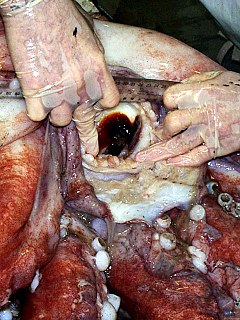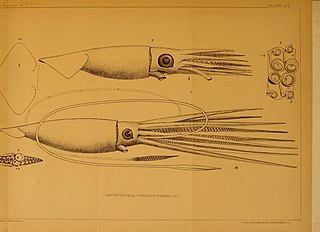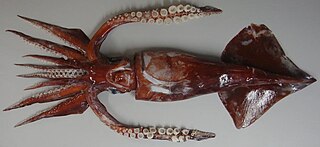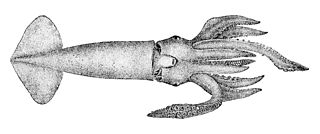
The hooked squid, family Onychoteuthidae, currently comprise about 20–25 species, in six or seven genera. They range in mature mantle length from 7 cm to a suggested length of 2 m for the largest member, Onykia robusta. The family is characterised by the presence of hooks only on the tentacular clubs, a simple, straight, funnel–mantle locking apparatus, and a 'step' inside the jaw angle of the lower beak. With the exception of the Arctic Ocean, the family is found worldwide.

Thysanoteuthis is a genus of large squid comprising one well-known species, the diamond squid, and two dubious taxa.

The Japanese flying squid, Japanese common squid or Pacific flying squid, scientific name Todarodes pacificus, is a squid of the family Ommastrephidae. This animal lives in the northern Pacific Ocean, in the area surrounding Japan, along the entire coast of China up to Russia, then spreading across the Bering Strait east towards the southern coast of Alaska and Canada. They tend to cluster around the central region of Vietnam.

Todaropsis eblanae, also known as the lesser flying squid, is a species of short finned squid in the monotypic genus Todaropsis of the family Ommastrephidae.
Aggregata is a genus of parasitic alveolates belonging to the phylum Apicomplexa.

All extant cephalopods have a two-part beak, or rostrum, situated in the buccal mass and surrounded by the muscular head appendages. The dorsal (upper) mandible fits into the ventral (lower) mandible and together they function in a scissor-like fashion. The beak may also be referred to as the mandibles or jaws.
Pseudahrensia is a genus of bacteria from the family of Phyllobacteriaceae.
Pseudahrensia todarodis is a Gram-negative, non-spore-forming, aerobic, rod-shaped and non-motile bacterium from the genus of Pseudahrensia which has been isolated from the gut of the squid Todarodes pacificus from the East Sea on Korea.

Sthenoteuthis oualaniensis, also known as the purpleback flying squid or purpleback squid, is a species of cephalopod in the family Ommastrephidae. It is native to tropical parts of the Pacific and Indian Oceans where it is found to depths of about 1,000 m (3,281 ft).

Sthenoteuthis is a genus of s a small genus of squid, with two species, part of the subfamily Ommastrephinae within the family Ommastrephidae, the "flying squids". They are the dominant species of flying squid in the world's tropical and subtropical seas and they are commonly seen at the ocean's surface during the night. Their size ranges from mantle lengths of 100mm to 600mm.

Todarodes is a genus of flying squid from the subfamily Todarodinae, of which it is the type genus. The genus contains five species which are partially allopatric but between them their distributions encompass most of the world's oceans and seas. These squid have a funnel groove with foveola, a hectocotylised fourth arm and tentacular stalks which lack free trabeculae.
The Angolan flying squid is a species of squid from the subfamily Todarodinae, part of the familyOmmastrephidae. Due to taxonomic confusion with the Antarctic flying squid the exact limits of its distribution are uncertain but it is thought to be restricted to waters off Southern Africa.

The Antarctic flying squid is a species of squid from the subfamily Todarodinae of the family Ommastrephidae, a family of pelagic squid from the order Oegopsida. It has a circumglobar distribution in the seas around the lower latitudes of the Southern Oceans.
The little flying squid is a species of squid, one of the arrow squids of the genus Todarodes, in the subfamily Todarodinae of the flying squid family Ommastrephidae. It is a small species from the waters around northern Australia and Indonesia.

The European flying squid is a species of squid from the continental slope and oceanic waters of the eastern Atlantic Ocean and the Mediterranean Sea. It is the type species of the genus Todarodes, the type genus of the subfamily Todarodinae of the pelagic squid family Ommastrephidae. It is a species which is targeted by some fisheries, although it is more often a bycatch.
Sedimentitalea todarodis is a Gram-negative, rod-shaped, aerobic and motile bacterium from the genus of Sedimentitalea, which has been isolated from the intestinal tract of the squid Todarodes pacificus from the Sea of Japan in Korea.














